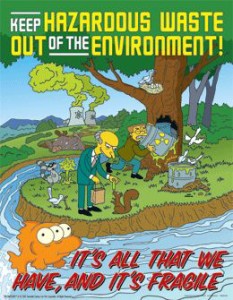
Despite Mr. Burns worst intentions, radioactive waste is not hazardous waste. Image via SafetyPoster.com
I am asked some version of this question or need to explain it nearly every month. What makes hazardous waste hazardous? Is this hazardous waste? What’s in hazardous waste?
The answer provided here isn’t intended for an environmental professional or hazardous material manager. It is for everyone else. No regulations, no citations, and nothing technical. Actually, I know a lot of environmental professionals who don’t work in the hazmat/waste field who would benefit from this. If you want the technical definitions and regulations, you can get them here from the EPA.
I’ve found that people have a generic, catch-all perspective that hazardous waste is all the “toxic stuff we have to throw out”. It is not a generic term. It has very specific characteristics and determinations.
Q: What is hazardous waste?
A: A waste chemical is hazardous waste if it falls into one or both of two categories.
1) Specific unused chemicals or from specific sources that the EPA has identified. These include degreasing operations, petroleum refining, pesticide manufacturing, and others. The EPA identifies all of them as listed here.
2) Wastes that have one or more of the following characteristics.
- Ignitable. If something is labeled, “Flammable”, then it will most likely be hazardous waste.
- Corrosive. Strong acids and bases. Remember the pH scale from chemistry class? It’s important here. If the pH is <=2 or >=12.5, it’s hazardous waste.
- Reactive. Stuff that is unstable under normal conditions. Like that lithium battery in your smart phone. That’s right; your smart phone has a toxic, reactive lithium battery in it.
- Toxic. Chemicals that you don’t want to absorb or ingest into your body. These include some pesticides, heavy metals (arsenic, lead, mercury), and organic compounds (benzene, chloroform).
That’s it. If it’s listed by the EPA or has one of those 4 characteristics, then it’s hazardous waste when we have to discard of it.
Q: Why do we care about hazardous waste?
A: Because we don’t want these harmful chemicals to end up in our bodies, our soil, our water, or our landfills. That is where they would end up if we didn’t control their disposal. In fact, that is exactly what happened before there were hazardous waste disposal rules. See: The Valley of the Drums.
Q: If it’s not hazardous waste, then it’s not hazardous, right?
A: No.
Used engine oil is not a hazardous waste. It’s not on EPA’s lists. It’s not flammable, corrosive, or reactive, and it might not be toxic enough to be considered “toxic.” But we don’t want it in our bodies, our dirt, or our water. Disposal of this is regulated, but not as hazardous waste.
And don’t say, “Well, it came from in the ground. Why is it bad to put it back on the ground?” Stop. Just, stop. I’ll have to cover that later.
Q: What isn’t hazardous waste?
A: Wastes that are commonly misidentified as hazardous waste are medical waste and radioactive waste.
